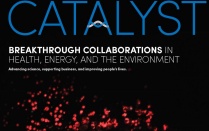Development of electrochemical energy technology solves environmental concerns

CBE PhD student Hanguang Zhang of the Wu research group was recently published in the Journal of The American Chemical Society.
Published January 5, 2018 This content is archived.
CBE PhD candidate Hanguang Zhang's primary interest is in the development of cathode catalysts for proton exchange membrane fuel cells (PEMFCs). PEMFCs are considered the most promising electrical power source for electrical vehicles due to their high energy density and elimination of CO2 emission by using H2.
Zhang is expected to graduate in Summer of 2018. He intends to continue the work for the development of electrochemical energy technology to solve environmental concerns after his graduation.
In his recent finding on replacing expensive and rare platinum-group metal (PGM) cathode catalysts with low-cost and earth-abundant materials for oxygen reduction reaction (ORR), Zhang was able to identify the atomic Fe dispersed PGM-free catalysts with high ORR activity similar to that of platinum/carbon catalysts, the catalysts derived from iron, nitrogen, and carbon (Fe-N-C) precursors. These high-performance atomic Fe catalysts have a high potential to replace the platinum catalysts in the future PEMFCs.
The unique atomic Fe dispersed Fe-N-C catalyst was prepared via the controlled chemical doping of Fe ions into zinc-based zeolite imidazole framework (ZIF) 3D networks, which then followed by one-step thermal activation to obtain a highly active atomic Fe dispersed catalyst without the formation of inactive Fe metallic agglomerates. Notably, the Fe ions are chemically bonded with N into Fe-N4 complexes, which connected within the 3D network of ZIF. Subsequent thermal activation converts these Fe-N4 complexes into ORR-active atomic FeN4 sites that embed into porous carbon phases. During the conversion, the particle size and shape of the Fe-doped ZIF polyhedron crystals are retained in the corresponding catalysts. Thus, the unique synthetic chemistry to control the ZIF crystal size (20–1000 nm) allows the investigation of size-dependent ORR activity for PGM-free catalysts. Similar to platinum nanoparticles, PGM-free carbon catalysts thus can be engineered with improved catalytic activity through exposing a large number of active sites and generating more effective porosity for mass transfer in fuel cell electrodes.
This finding is published in the 2017 Journal of The American Chemical Society (JACS), which is a weekly journal in American Chemical Society. [read the full paper]




